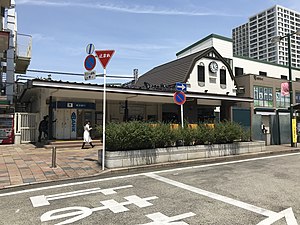Mukōgaoka-Yūen station
| Mukōgaoka-Yūen ( 向 ヶ 丘 遊園 ) | |
|---|---|
|
South entrance to the train station (May 2019)
|
|
| Data | |
| Location in the network | Through station |
| Platform tracks | 4th |
| abbreviation | OH15 |
| opening | April 1, 1927 |
| location | |
| City / municipality | Kawasaki |
| prefecture | Kanagawa |
| Country | Japan |
| Coordinates | 35 ° 37 '2 " N , 139 ° 33' 53" E |
| Height ( SO ) | 22 m TP |
| Railway lines | |
|
Decommissioned: |
|
| List of train stations in Japan | |
The train station Mukōgaoka-Yūen ( Japanese. 向 ヶ 丘 遊園 駅 , Mukōgaoka-Yūen-eki ) is a train station on the Japanese island of Honshū . It is located in Kanagawa Prefecture in Kawasaki City , more precisely in Tama-ku District .
links
Mukōgaoka-Yūen is a through station on the Odakyū Odawara Line from Shinjuku to Odawara , which is operated by the Odakyū Dentetsu railway company . All local and express trains stop here , with the exception of the Limited Express (Tokkyū) and Rapid Express (Kaisoku kyūkō) train types . During the day there are up to twelve trains every hour and up to 21 trains during rush hour. These run out of town to Odawara, Hakone-Yumoto , Karakida or Katase-Enoshima . In the opposite direction they run to Shinjuku or are connected to the Chiyoda line of the Tokyo subway in Yoyogi-Uehara . Local trains on the Odawara Line usually connect Shinjuku with Hon-Atsugi . There are bus stops around the station forecourt. These are served by six lines of the Kawasaki City Traffic Department and the Tōkyū Bus company.
investment
The station is in the Noborito district, which is part of the Tama-ku district. The private Senshū University and the Nihon Minka-en Open Air Museum are nearby . The facility is oriented from northeast to southwest and has four tracks, all of which are used for passenger traffic. These are located on two completely covered central platforms , which are connected to the reception buildings on the north and south sides via a covered pedestrian bridge . The southern one dates from the beginning of the Odawara line and has a striking mansard roof . In the direction of Odawara there is a turning track between the tracks . While the Odawara line has three tracks in the direction of the city center, it still has two tracks out of town.
In the 2018 fiscal year, an average of 67,518 passengers used the station every day.
Tracks
| 1/2 | ▉ Odakyū Odawara lineage | Odawara • Hakone-Yumoto • Karakida • Katase-Enoshima |
| 3/4 | ▉ Odakyū Odawara lineage | Noborito • Yoyogi-Uehara • Shinjuku |
history
The station was opened on April 1, 1927 by the private railway company Odakyū Dentetsu , along with the entire Odakyū Odawara line between Shinjuku and Odawara . The station was initially called Inada-Noborito ( 稲 田 登 戸 ). On June 14 of the same year, the Mukōgaoka-Yūen amusement park opened its doors, which was about a kilometer away. In order to develop it better, the Odakyū Dentetsu took a narrow-gauge excursion railway leading there into operation on the same day. A train with a diesel locomotive was used (from 1955 with a battery electric locomotive ). From October 15, 1927, express trains also stopped. Due to the war and a lack of demand, the station lost its status as an express train stop in November 1944. He received this again in 1952, when the number of passengers began to rise sharply in the course of the Japanese economic growth.
On April 1, 1955, the station was given its current name to underline its importance for and proximity to the theme park. Due to the expansion of Prefecture Street 9, the excursion train had to be canceled in autumn 1965 and was replaced by a monorail . The opening of the Mukōgaoka-Yūen Monorail , which is also the Odakyū Dentetsu, took place on April 23, 1966. Its terminus was above the median of the access road to the southern station forecourt. The monorail ceased operations on February 13, 2000 and was canceled a year later. A bicycle parking facility has been located at the location of the former monorail station since 2004 . The supporting pillars of the driveway were partially rebuilt in a smaller form and provided with climbing aids for plants. A sign in front of the train station reminds of the former monorail.
In 1991 the station reached its highest capacity ever with 71,254 passengers per day. Passenger numbers have declined somewhat since then, mainly due to the shutdown of the monorail and the closure of the amusement park in 2002.
Adjacent train stations
|
←
|
Lines |
→
|
||
|---|---|---|---|---|
| Noborito |
Odakyū Dentetsu |
Ikuta | ||
| Beginning |
Odakyū Dentetsu (1966-2000) |
Mukōgaoka-Yūen-seimon | ||
Web links
- Station information of Odakyū Dentetsu (Japanese)
Individual evidence
- ↑ Weekday schedule to Shinjuku. Odakyū Dentetsu , 2020, accessed April 30, 2020 (Japanese).
- ↑ 鉄 道 部門 : 1 日 平均 駅 別 乗 降 人員. Odakyū Dentetsu , 2018, accessed April 30, 2020 (Japanese).
- ↑ Yoshio Ikukata: 向 ヶ 丘 遊園 モ ノ レ ー ル . In: Tetsudō Pikutoriaru . (Archives Selection). No. 2 . Denkisha kenkyūkai, Chiyoda December 2002, p. 91-94 .
- ↑ 甦 る 読 者 短信 & Topic Photos . In: Tetsudō Pikutoriaru . (Archives Selection). No. 2 . Denkisha kenkyūkai, Chiyoda December 2002, p. 130 .



